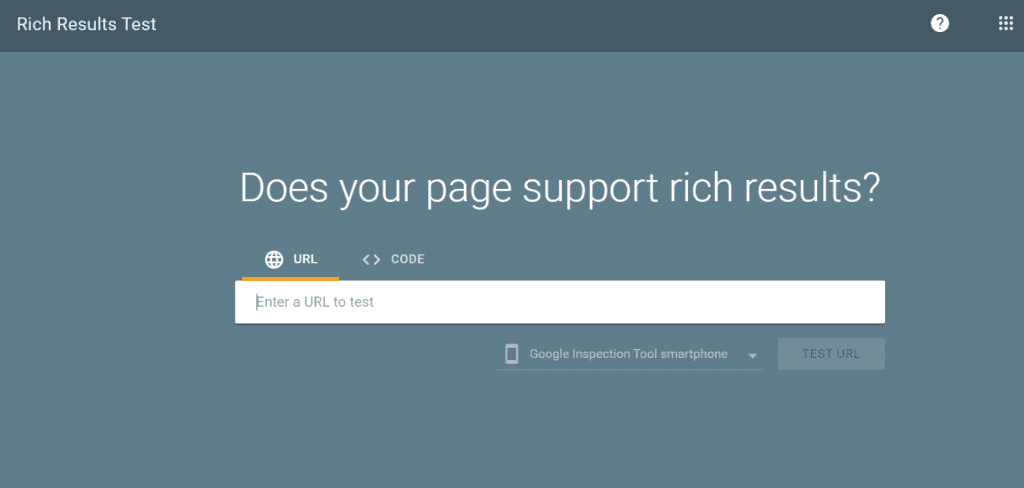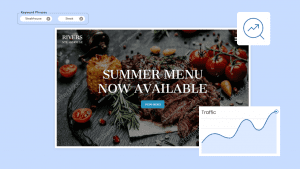Key takeaways:
- On-page SEO improves your site’s structure, content, and user experience, all within your control.
- Off-page SEO builds authority through backlinks, brand mentions, and social engagement.
- A balanced strategy using both is essential for driving traffic, visibility, and business growth.
Search engine optimization (SEO) is critical for small businesses that want to compete online. However, many business owners are unsure where to start or how to split their efforts between on-page SEO and off-page SEO.
This guide breaks it down simply so you can understand what matters, why it matters, and how to take action to improve your search rankings and drive results.
Difference between On-page vs Off-page SEO
| Characteristic | On-page SEO | Off-page SEO |
| What it is | Optimizing elements directly on your website | Actions taken outside your website to improve its standing |
| Primary objective | Enhancing the quality and relevance of your web pages | Boosting your website’s authority and external reputation |
| Core components | Content optimization, technical adjustments, site structure | Backlink acquisition, social signals, brand mentions |
| User interaction | Directly impacts how users experience your site | Indirectly influences user perception through external trust |
| Speed considerations | Crucial for user experience and search engine ranking | No direct influence, but a strong site (on-page) will be fast |
| Mobile adaptability | Essential for accessibility and search engine performance | Less direct, but overall online presence benefits from mobile |
| Technical aspects | Involves site indexing, crawlability, and schema markup | Focuses on external validation and link equity |
| Link focus | Optimizing internal links within your own domain | Building high-quality, relevant external links pointing inward |
| Social media role | Can be integrated for content promotion on your site | Leveraging platforms for outreach, sharing, and brand visibility |
| Authority development | Aiming to create comprehensive and authoritative content | Establishing your domain as a trusted voice in your niche |
| Content strategy | Producing valuable, keyword-optimized content for your site | Distributing and promoting content across external channels |
What is On-page SEO?
On-page SEO refers to all the actions you can take to improve your website’s search engine visibility. It’s entirely in your control and includes everything from keywords and content structure to page speed and mobile experience to improve their visibility in search engine results and attract more relevant traffic. Unlike off-page SEO, it involves elements entirely within your control.
This includes optimizing title tags, meta descriptions, URLs, and header structures, as well as incorporating relevant keywords naturally within high-quality content. It also covers technical aspects like improving page load speed, ensuring mobile friendliness, and using internal links effectively. All these efforts work together to help search engines better understand your content and provide a smoother, more engaging experience for visitors.
Here are the key elements of effective on-page SEO you should focus on:
- Keyword optimization
- Meta tags and headers
- Content quality and readability
- Image optimization
- Core Web Vitals and page speed
- Mobile responsiveness
- Schema markup
- Internal linking strategy
- A/B testing for SEO
Now, let’s dive deeper into each of these components and how to implement them effectively.
Keyword optimization
Start with primary and secondary keywords that match what your audience is searching for. Incorporate them naturally into your headlines, subheads, body text, and meta descriptions. These keywords should reflect the intent behind common queries related to your products, services, or content.
Once identified, integrate them naturally throughout your content, including headlines, subheadings, body copy, image alt text, and meta descriptions, without overstuffing. This helps search engines understand the context of your page while ensuring your content remains readable and engaging for users. Remember, the goal is to strike a balance between relevance for algorithms and value for humans.
Meta tags and headers
Craft compelling and concise title tags and meta descriptions that accurately reflect your page content while encouraging users to click through from search engine results. These meta elements are often the first impression a potential visitor has of your site, so make them count by including relevant keywords and a clear value proposition.
In addition, use a logical and consistent heading structure to organize your content, starting with a single H1 tag for the main page title, followed by H2s for primary sections and H3s for supporting subpoints. A well-structured hierarchy not only enhances readability for users but also helps search engines better understand and index your content.
Content quality and readability
High-quality content clearly and concisely answers the user’s intent. To improve readability, use short paragraphs, active voice, and tools like Hemingway Editor. Avoid keyword stuffing.
Creating high-quality content means delivering clear, accurate, and useful information that directly addresses the user’s search intent. Your content should provide genuine value, backed by credible sources when necessary, and be tailored to your target audience’s level of understanding.
To enhance readability, break text into short paragraphs, use active voice, and include headings, bullet points, and visuals to make scanning easier. Tools like Hemingway Editor or Grammarly can help simplify your writing and highlight areas for improvement.
Avoid keyword stuffing—focus instead on natural keyword integration that supports the flow and clarity of your message. Well-written, reader-friendly content not only improves SEO but also builds trust and encourages engagement.
Image optimization
Compress images for faster load times and use descriptive alt-text. Use WebP formats where possible to enhance performance without sacrificing quality. Optimizing images is essential for improving page load speed and overall site performance, both of which directly impact user experience and SEO. Start by compressing images to reduce file size without compromising visual quality.
Use modern formats like WebP whenever possible, as they offer superior compression compared to traditional formats like JPEG and PNG. Always include descriptive alt-text for each image, not only to improve accessibility for users with screen readers but also to help search engines understand the content of your visuals.
Additionally, use responsive image sizes (srcset) so your site can serve the right image dimensions based on the user’s device. Proper image optimization ensures a faster, more accessible, and search-friendly website.
Core Web Vitals and page speed
Google evaluates user experience with metrics like Largest Contentful Paint (LCP) and Cumulative Layout Shift (CLS). Test and improve your scores with Google PageSpeed Insights. Core Web Vitals are a set of performance metrics that Google uses to measure real-world user experience on your website.

Key metrics include Largest Contentful Paint (LCP), which measures loading performance; Cumulative Layout Shift (CLS), which gauges visual stability; and First Input Delay (FID) or Interaction to Next Paint (INP), which track interactivity. These factors directly impact how users perceive your site’s speed and usability.
To improve these scores, use tools like Google PageSpeed Insights or Lighthouse to diagnose issues and apply optimizations such as compressing images, leveraging browser caching, reducing JavaScript execution time, and using a content delivery network (CDN). A faster, more stable website leads to higher engagement and better search rankings.
Mobile responsiveness
Your website must display well on all devices. Use responsive design and appropriate font sizes, and avoid elements that require pinch-zooming or horizontal scrolling. Ensuring your website is mobile responsive is essential for both user experience and SEO. A mobile-responsive site automatically adjusts its layout, content, and elements to fit different screen sizes, from smartphones to tablets and desktops.
Use a responsive design framework that adapts seamlessly across devices, with readable font sizes, appropriately spaced buttons, and layouts that eliminate the need for pinch-zooming or horizontal scrolling. Google also prioritizes mobile-friendly websites in its search rankings, so optimizing for mobile not only improves usability but also boosts your visibility in search results.
Schema markup
Add structured data to help search engines understand your content and qualify for rich results. Use schema for products, reviews, FAQs, and more. Schema markup, or structured data, is a type of code you add to your website to help search engines better understand the context and meaning of your content.
By implementing schema, you increase the chances of your pages appearing as rich results, such as star ratings, product details, event information, and FAQs, directly in search listings.
This not only enhances visibility but can also improve click-through rates. Use relevant schema types for your content, such as Product, Review, FAQ, Article, or LocalBusiness, and validate your markup using tools like Google’s Rich Results Test to ensure proper implementation.

Internal linking strategy
Implement a thoughtful internal linking strategy by using clear, descriptive anchor text that accurately reflects the content of the page being linked to. This not only improves user experience by guiding visitors to related and valuable information, but also strengthens your site’s SEO by helping search engines understand the relationship between different pages.
Strategically linking to cornerstone content or high-converting pages can distribute link equity, enhance site structure, and support keyword relevance across your domain. Be consistent, avoid over-linking, and ensure each link adds value to the user’s journey.
Use descriptive anchor text to link to relevant pages within your site. This helps users navigate and signals content relevance to search engines.
A/B testing for SEO
Test different title tags, meta descriptions, and CTAs to see what drives higher engagement and click-through rates. Even small changes can yield valuable insights.
Mini checklist:
- Keyword integration
- Meta tags
- Structured headings
- Optimized images
- Mobile-friendly design
- Page speed improvements
- Internal links
- Schema markup
Where does technical SEO fit in?
While this guide focuses on on-page and off-page SEO, it’s important to understand the third pillar: technical SEO. This involves backend optimizations that help search engines crawl, index, and render your site more efficiently.
Key aspects of technical SEO include:
- Site speed and server response time
- Mobile friendliness
- Secure HTTPS protocols
- XML sitemaps and robots.txt
- Structured data (schema markup)
- Structured data (schema markup)
- Fixing crawl errors and broken links
Without a solid technical foundation, even the best on-page content and off-page backlinks can underperform. Think of technical SEO as the infrastructure that supports your entire SEO strategy.
What is Off-page SEO?
Off-page SEO includes all the external signals influencing your site’s authority and visibility. You can influence these things—but not directly control—like backlinks, brand mentions, and online reputation.
Off-page SEO refers to all the activities and external signals that occur outside your website but impact its authority, credibility, and visibility in search engine results. While you can’t directly control these factors, you can influence them through strategic efforts.
Key components include backlinks from reputable websites, brand mentions across the web, social media engagement, online reviews, and overall digital reputation.
These signals help search engines gauge how trustworthy and valuable your site is to users. A strong off-page SEO strategy not only boosts rankings but also builds long-term brand recognition and authority within your niche.
Here are the key elements of an effective off-page SEO strategy:
- Link building techniques
- Local SEO and citations
- Digital PR and brand mentions
- Social signals and engagement
- Online reviews and reputation management
- Influencer collaborations
- Content syndication
Now, let’s dive deeper into how each of these elements strengthens your site’s authority and boosts search visibility.
Link building techniques
Building high-quality backlinks is essential for improving your website’s authority and search engine rankings. Below are some effective link building techniques you can use to attract relevant, trustworthy links to your site:
- Guest posting on relevant industry blogs
- Using and “best of” guides
Local SEO and citations
Consistent Name, Address, and Phone Number (NAP) listings across directories like Yelp, Google Business Profile, and industry-specific platforms are crucial for local businesses.
How does local SEO and citations work?
Local SEO helps your business appear in geographically relevant searches (like “plumber near me” or “best bakery in [city]”). A key component of local SEO is citations—mentions of your business’s Name, Address, and Phone number (NAP) on directories like Google Business Profile, Yelp, Bing Places, and industry-specific sites.
How citations support local SEO:
- Consistent NAP info signals trust to search engines.
- Citations help search engines verify your location and business category.
- High-quality, accurate citations can improve your visibility in local pack results and Google Maps.
To maximize impact:
- Ensure NAP consistency across all platforms.
- Use schema markup for your business details.
- Collect reviews and keep your listings updated.
Digital PR and brand mentions
Submit pitches to journalists via HARO, participate in podcasts, or create original research that others will cite. These helps build authority and drive links.
Social signals and engagement
While social media isn’t a direct ranking factor, shares and engagement help amplify your content and drive referral traffic. Maintain active profiles and encourage shares.
Mini checklist:
- Backlink outreach
- Citation consistency
- Guest contributions
- Brand Features
- Active social presence
How does local SEO support off-page strategy?
For small businesses, local SEO is a high-impact form of off-page SEO. It includes getting listed in directories like:
- Google Business Profile
- Yelp
- Bing Places
- Industry-specific directories (e.g., Houzz, TripAdvisor)
Make sure your NAP (Name, Address, Phone) info is consistent across platforms. Encourage reviews and actively respond to them—Google considers this a strong trust signal.
Local citations, combined with quality backlinks, can dramatically improve local search visibility, especially in map packs.
Digital PR and brand mentions
Submit pitches to journalists via HARO, participate in podcasts, or create original research that others will cite. These helps build authority and drive links.
Social signals and engagement
While social media isn’t a direct ranking factor, shares and engagement help amplify your content and drive referral traffic. Maintain active profiles and encourage shares.
Mini checklist:
- Backlink outreach
- Citation consistency
- Guest contributions
- Brand Features
- Active social presence
Time to see results from On-page vs.Off-page SEO
| SEO type | Typical time to impact | Key influencers |
| On-page SEO | 1–4 weeks | Site speed, content quality, keyword use |
| Off-page SEO | 2–6+ months | Backlink quality, brand mentions, PR |
| Technical SEO | Immediate to 2 weeks | Indexing issues, site errors, mobile UX |
Tools and resources to streamline SEO
Leveraging the right tools can save you time and effort while boosting your SEO performance. Here are some essential tools and resources to help you analyze, optimize, and track your SEO strategy more efficiently:
- Semrush. On-page SEO checker, backlink audits
- Ahrefs. Keyword research, link intersect tool
- Google Search Console. Performance monitoring, index coverage
- Yoast SEO or RankMath. Content optimization
- MozBar. Instant page metrics and link insights
SEO in the era of AI and zero-click results
As search engines evolve with AI and deliver more answers directly on the results page, traditional SEO strategies need to adapt. Here’s what you need to know about optimizing for visibility in an era where clicks aren’t guaranteed.
To stay competitive:
- Use clear headers and structured formatting
- Implement FAQ schema and featured snippets
- Focus on page speed and mobile experience
- Write in a conversational tone with simple, direct answers
Step-by-step SEO plan for small business owners
SEO can feel overwhelming, especially for small business owners with limited time and resources. This simple, step-by-step plan breaks down the essentials to help you build a strong online presence and attract more customers through search.
- Start with an on-page audit using tools like PageSpeed Insights and Yoast.
- Optimize content for target keywords and readability.
- Improve internal linking and add schema.
- Launch a monthly backlink campaign (guest posts, listicle outreach, HARO).
- Track performance in Google Search Console.
- Repeat and refine based on results.
Boost your visibility with expert SEO help
Understanding the difference between on-page and off-page SEO is key to building a well-rounded strategy. On-page SEO ensures your site is technically sound and content-rich, while off-page SEO builds credibility and authority through backlinks and mentions. Together, they create the foundation for long-term search success.
Want personalized SEO solutions that deliver real results? Talk to our experts today and discover how we can help your business grow with a customized strategy.
Frequently asked questions
On-page SEO focuses on optimizing elements within your website like content, keywords, meta tags, and internal links to improve search visibility. Off-page SEO, on the other hand, involves external factors such as backlinks, brand mentions, and online reputation that influence your site’s authority and ranking.
Start with the basics: make sure your website is mobile-friendly, loads quickly, and has clear, relevant content. Then, focus on keyword research, optimizing on-page elements like title tags and meta descriptions, and setting up Google Business Profile if you serve local customers. These simple steps build a strong foundation for your SEO success.
How long does SEO take to show results?
SEO is a long-term strategy. For most small businesses, it can take about 3 to 6 months to see noticeable improvements, but it depends on your industry, competition, and how consistently you apply best practices. Unlike paid ads, SEO builds lasting results that compound over time.
Local SEO and off-page SEO work hand in hand. Local SEO focuses on optimizing your online presence for local searches—like managing your Google Business Profile and getting listed in local directories. Off-page SEO boosts your credibility through backlinks, reviews, and mentions on other sites. Together, they help your business rank higher and attract nearby customers.
A high-quality backlink comes from a reputable, relevant website with strong domain authority. It should be contextually placed within valuable content, drive referral traffic, and align with your niche. The best backlinks often come from sources that rank well for related long-tail keywords and help close gaps found in competitor backlink profiles.




